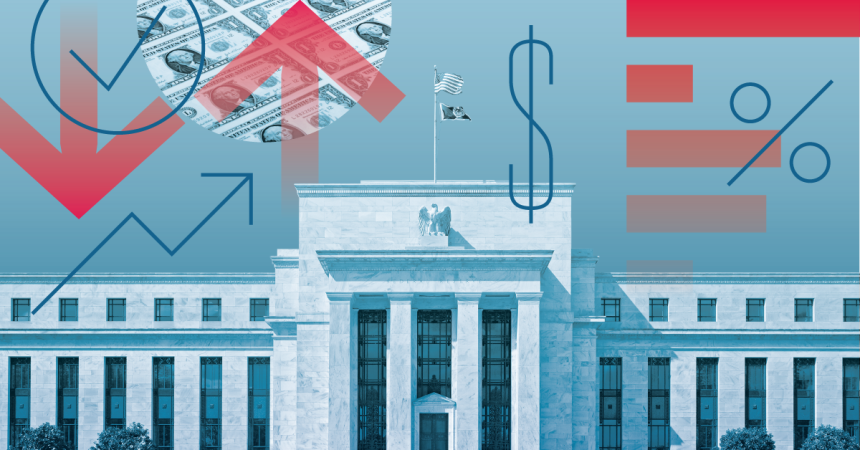In the world of interest-rate markets, there is a commonly known phenomenon referred to as “the hairy chart”. This chart depicts the Federal Reserve’s policy rate as a prominent line over time on the x-axis, with smaller lines branching out from it. These smaller lines represent the market’s expectations for future interest rate movements at different points in time.
Observing this chart can lead to two conclusions. Firstly, it may appear as if a mathematician was asked to draw a sea monster. Secondly, it becomes evident that even the collective wisdom of highly sophisticated investors and traders is highly unreliable when it comes to predicting interest rate movements.
Ever since inflation started to rise in 2021, the forecasts regarding the Federal Reserve’s actions have consistently been inaccurate. These predictions have often failed to appropriately gauge the Fed’s inclination to increase interest rates or have overestimated the speed at which it would begin to decrease them. Therefore, it is puzzling to interpret the current scenario where the interest-rate market is indicating an anticipation of swift easing in monetary policy.
In a significant shift, the Federal Reserve has changed its stance on interest rates. Just a year ago, investors who believed rates would be reduced were at odds with the Fed, as its rate-setters did not anticipate such a move. However, in December, the central bank changed its position. Jerome Powell, the chairman, announced that rate cuts were now being considered, and officials projected three cuts (equivalent to 0.75 percentage points) in 2024.
The market has since surpassed these expectations, pricing in the possibility of five or six cuts by the end of this year. Interestingly, the market is now aligning with the Fed’s position, rather than opposing it. This shift allows Mr. Powell to express more accommodative views, as inflation has significantly declined. In fact, consumer prices only increased by 3.4% in the year leading up to December, compared to a 6.5% increase in the previous month.
However, recent years have demonstrated the tendency of investors to be overly optimistic about potential interest rate cuts, often leading to incorrect predictions. Therefore, it is important to question if they are repeating the same error once more. It is evident that a scenario in which interest rates remain elevated for an extended period is still highly plausible.
Let’s start by examining the factors that have contributed to the decrease in inflation so far. While the rapid increase in interest rates certainly played a part, it is likely that the diminishing impact of supply shocks had a more significant influence. As supply chains became less disrupted, workers who were previously under lockdown were able to return to the labor market, and the exceptionally high energy prices began to decline. Essentially, the negative supply shocks were replaced by positive ones, leading to a decrease in inflation despite the resurgence of economic growth.
However, the positive impacts that have been experienced are beginning to diminish. The supply chains that were previously unraveled cannot become any more unraveled. The participation rate in the US labor force, which increased from 60% in April 2020 to 63% in August of last year, has now plateaued. Additionally, energy prices have stopped declining since early 2023.
The escalating violence in the Middle East poses a potential risk for America and Israel, as they could be drawn into further conflicts with Iran and its oil-producing allies and proxies. This situation may cause prices to rise once again. As a result, the Federal Reserve will need to take further action in order to continue lowering inflation rates.
While the participation rate in America has leveled off, wages have continued to increase. The Atlanta Federal Reserve reports that in the fourth quarter of 2023, median hourly earnings were 5.2% higher compared to the previous year.
Taking inflation into account, this growth rate surpasses the long-term average for workers’ productivity, which has been slightly above 1% since the global financial crisis of 2007-09. The disparity between wage and productivity growth suggests that prices will continue to rise, making it more challenging for the Federal Reserve to justify rate cuts.
It is possible that interest rates may remain high, even without considering the political situation. However, in an election year, central bankers do not have the luxury of ignoring the political backdrop. The Federal Reserve is already facing the risk of easing monetary policy too early and allowing inflation to resurge, similar to what happened in the 1970s.
This risk becomes even more significant during a presidential campaign featuring Donald Trump, as cutting rates too quickly could have severe consequences. Officials would face criticism for abandoning their mandate in an attempt to stimulate the economy, gain voter support, and prevent Mr. Trump from being reelected.
If Mr. Trump is successful in winning, there is a possibility that he will implement tax cuts funded by deficits. This could potentially lead to an increase in inflationary pressure, causing the Federal Reserve to raise interest rates. While this scenario is currently speculative fiction, it is not something that investors are anticipating. However, considering their track record of predictions, this does not provide much comfort.
